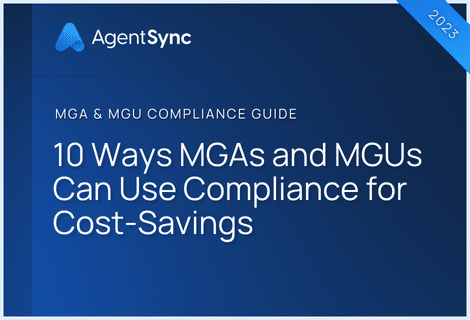

The last section of this article has been updated to include new information.
Banking insurance, commonly known in the U.S. under the name of the Federal Deposit Insurance Corporation (FDIC), is a unique insurance “product.” Unlike most other insurance coverages, those who benefit from it (consumers and businesses) never pay a premium, or even make a purchasing decision.
The concept of a banking system has been around in one form or another for a really long time: as far back as 2000 BC to be exact! Insurance is also a historic industry, originating in the Middle Ages. Banking insurance, the idea of insurance coverage for the money banks hold on behalf of customers, is quite modern by comparison. In the U.S., it only came into existence less than 100 years ago.
Banking insurance isn’t the type of insurance we normally write about on the AgentSync blog, but it’s been making headlines recently as the FDIC stepped in to rescue depositors at Silicon Valley Bank during its recent solvency crisis. Given it’s having a moment in the spotlight, what better time to dig into a brief history of banking insurance and the FDIC?
Origins of the FDIC
The banking system has been a cornerstone of the American economy since its inception, providing capital for businesses and individuals and giving people a safe place to store their funds. Not to mention, banking gives us the ability to transfer money from place to place. If it weren’t for banks, you couldn’t Venmo your friend for dinner, and what kind of world would that be?
The amazing level of convenience that comes along with the modern banking system also brings a level of risk. Banks are vulnerable to financial crises involving their liquidity, their solvency, or even fraudulent activity.
To protect depositors from losing their money in these situations, the U.S. government established the FDIC in 1933 during the Great Depression. The FDIC’s goal is to promote public confidence in the banking system by insuring deposits and encouraging sound banking practices. This independent agency is funded by premiums paid by member banks and (as of 2022 data) insures over 71,000 branches of 4,000 banks across the country.
The Great Depression and the FDIC
The Great Depression, which began on Oct. 28, 1929, with a day now known as Black Monday, left millions of Americans out of work and in poverty. As the stock market crashed and people ran to their banks demanding cash, the banking system sank into deeper and deeper trouble. Hindsight is, of course, 20/20, and we now know that Americans’ lack of confidence in the banking system as a whole was a large contributing factor to the depth of the Great Depression.
In an effort to restore faith in the banking system and stabilize the economy, President Franklin Roosevelt signed into law the Banking Act of 1933, which established the Federal Deposit Insurance Corporation. The FDIC’s primary role was to insure bank deposits up to a certain amount, thus guaranteeing customers wouldn’t lose all their money if a bank failed. The law also gave the FDIC the power to regulate banks and make sure they were following sound banking practices – hopefully avoiding another major financial meltdown.
Roles and responsibilities of the FDIC
The FDIC is a federal agency funded by assessments from the banks and savings associations it insures. Its primary role is to protect the stability of the entire U.S. banking system by assuring bank customers that their money is safe. Beyond that, the FDIC also has the authority to examine and supervise its member institutions.
To accomplish this, FDIC examiners conduct regular on-site reviews of every insured bank and savings association at least once every 18 months. They review loan portfolios, look at each bank’s level of capital and liquidity, track compliance with consumer protection laws, review management practices, and much more.
In addition to looking closely at individual institutions, the FDIC also conducts industry wide exams to assess the collective condition of all insured banks and institutions. The FDIC then uses its findings to inform policy decisions regarding how best to protect consumers’ deposits while also encouraging safe banking practices throughout the industry.
In a related vein, the FDIC also functions to provide consumers with accurate information to help them make better choices related to banks and deposits. The FDIC’s website is full of detailed information about any member banks, including details on the financial health of each bank. One of the most helpful consumer-facing tools the FDIC provides is its Electronic Deposit Insurance Estimator (EDIE). This online tool lets banking customers estimate how much coverage they would receive if their bank fails based on their deposit amount spread across different accounts at multiple banks.
Banking insurance limits
Knowing your money is protected by an insurance policy that will cover your savings if your bank experiences a crisis is definitely reassuring for consumers. But FDIC insurance coverage isn’t a free-for-all. Like most insurance policies, it has limits on how much it will pay. So, it’s critical for depositors to be aware of these limits to make sure they aren’t leaving large amounts of money uninsured.
When President Roosevelt established the FDIC in 1933, the insurance limit was a mere $2,500. Translated into 2022 dollars, that would be a bit over $56,000. Luckily for people with more than that in the bank, the FDIC limit has increased over time and currently sits at $250,000 per person per insured bank account. This means joint accounts can receive up to $500,000 of coverage. It’s important for consumers to be aware of and consider these coverage limits when deciding where and how to save large amounts of money.
FDIC banking insurance exclusions
The FDIC insures deposits at a variety of banks and for many types of accounts. These include checking and savings accounts, certificates of deposit (CDs), money markets accounts, and others. It’s important to know that FDIC insurance doesn’t apply to securities like stocks, bonds, and mutual funds. Basically, investments that are risky by design are not insured the way deposits into a variety of more normal “bank accounts” are.
While there’s no insurance protection against simply losing money in a market, as markets fluctuate by their very nature, consumers may want to look into other types of protection, like the protection of the Securities Investor Protection Corporation (SIPC), which covers losses due to broker failure or fraud. This is more like errors and omissions insurance if your investment broker does something wrong. But again, it’s not a guarantee on the value of your account the way FDIC insurance is.
Alternatives to FDIC insurance
If you bank at a credit union rather than a literal bank, your accounts are not FDIC insured. To protect consumers who use credit unions, a similar insurance exists via the National Credit Union Administration (NCUA). This fund provides up to $250,000 per account holder and covers all deposits at federally insured credit unions.
FDIC banking insurance in the news: The fall of Silicon Valley Bank
As we mentioned above, the FDIC insures deposits up to $250,000 in case of a bank failure. So, what happens when a bank caters to Silicon Valley tech startups and has an average deposit size of $5 million? This was the scenario Silicon Valley Bank (SVB) and its customers faced in March of 2023.
If the FDIC had held to its core promise and guaranteed SVB’s customers only up to their first $250,000, the fallout could have been catastrophic. Tech companies with their entire savings at SVB would fail to make payroll or pay other essential bills. Even if SVB had enough assets to eventually honor all its deposits, it could have taken months or years for customers to get access to that money and it would be too late for their businesses.
History has shown this to be an even more dangerous situation for the economy because once one bank fails, the ripple effect across businesses, other banks, and the entire economy can get out of control. This is why the FDIC acted quickly to approve a systemic risk exception and fully guarantee SVB account holders access to their funds, despite 95 percent of those funds being uninsured.
To avoid a repeat of this situation, the FDIC also began working on new regulations almost as soon as the imminent SVB crisis passed. The proposal, introduced mid-2023, would implement the final pieces of the Basel III agreement, also called Basel III endgame. Additionally, though separate from the implementation of the Basel endgame, the Federal Reserve suggested changes to how it calculates the extra capital that very large and important banks (known as Global Systemically Important Banks or G-SIBs) need to have on hand, along with changes to the Systemic Risk Report (FR Y-15), a report that helps assess risks in the banking system.
According to an FDIC report, the two main goals of these revised regulations would be to “[i]mprove consistency of risk measurement in the capital rule for large banking organizations,” and to “[a]pply the capital standards for large banking organizations to a broader set of large banking organizations.” The proposed new regulations were open for public comment through Nov. 30, 2023 and are expected to begin taking effect in July of 2025. As of this writing, final rules haven’t been published.
Although the FDIC acted above and beyond its typical role in the SVB case, and although SVB itself didn’t survive the crisis, we’re happy to report that insurance saved the day for the people and businesses who rely on the stability of our banking system. You might even say that insurance was the hero of this story. And if you work in insurance, then you’re a real insurance hero, too! Whether you’re looking to reduce compliance risk, save costs, increase efficiency, or wow your producer force with how fast and easy it is to start selling, AgentSync is the solution that powers real insurance heroes across the industry. Contact us today to see how we can help.

